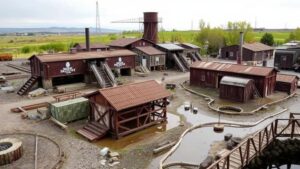Exploring Forgotten Glassworks for Manufacturing Artifact Discoveries
Exploring Forgotten Glassworks for Manufacturing Artifact Discoveries
The field of industrial archaeology often focuses on understanding the processes and artifacts of past manufacturing practices. Among these, glassworks stand out due to their rich histories and the complexities of glass production. This article explores forgotten glassworks, examining their historical significance, the artifacts found within, and the implications for contemporary understanding of industrial practices. Notably, we will consider case studies from various locations, bringing to light the nuances involved in glass manufacturing across different eras.
Historical Overview of Glass Manufacturing
The origins of glass-making date back to around 2000 BCE in Mesopotamia and Egypt. These ancient practices evolved over centuries, giving rise to different techniques such as glassblowing and molding. By the 18th century, glass production had expanded significantly, especially in Europe and America. Key industries emerged, such as the glassworks established in regions like Venice, Italy, and later, the Newark Glass Factory in New Jersey, which became one of the foremost glass producers in the United States during the 19th century.
- Venetian Glass (15th-18th Century): Known for intricate designs and vibrant colors.
- Newark Glass Factory (Est. 1825): Introduced innovative glass production techniques in America.
Revisiting Forgotten Glassworks
Many historic glassworks have fallen into disrepair or have been completely forgotten. The exploration of these sites often yields valuable artifacts and insights. For example, the remains of the Wheaton Village in Millville, New Jersey, provide a glimpse into 19th-century glass production methods. Studies conducted by the WheatonArts Cultural Center reveal the technological advancements in glassblowing and mold-making that were characteristic of the period.
Artifacts and Their Significance
The artifacts recovered from these sites play a crucial role in understanding the socio-economic context of glass production. These can include production tools, decorative pieces, and even waste products from glass-making processes. For example, a study on the remnants from the Tripoli Glassworks in Tripoli, Pennsylvania, revealed unique glass marbles that were not only childrens toys but also highlighted a local entrepreneurial spirit that contributed to community identity in the 20th century.
- Glassblowing Tools: Items like blowpipes and pontils indicate methods used.
- Wastage Products: Clues to design practices and operational challenges.
Methodologies for Exploration
The exploration of forgotten glassworks typically involves a combination of archaeological methods and historical research. Primary methodologies may include:
- Field Excavation: Systematic excavation to uncover layers of waste and artifacts.
- Document Analysis: Review of historical documents, such as production logs and advertisements.
- Material Analysis: Chemical analysis of glass composition to determine origins and production techniques.
For example, the practice of geochemical sourcing has allowed researchers to trace the origins of glass artifacts back to specific locations, as demonstrated in studies of ancient Roman glassware analyzed for raw materials in the surrounding regions.
Case Studies: Insights from Explorations
Several important case studies exemplify the findings from forgotten glassworks:
- Murano Island Glassworks, Italy: Here, research revealed the transition to industrialization in glass making through artifacts that represented both artisanal and machinery-driven production.
- Thomas/Webster Glassworks, Maryland: Analyses showed how economic downturns led to innovative recycling practices, evidenced by mixed glass compositions found in archaeological digs.
Contemporary Applications and Implications
The lessons gleaned from these explorations are significant in the context of modern manufacturing practices. They provide insights into:
- Resource Management: Historically, manufacturers adapted to resource scarcity, a practice that resonates with today’s sustainability challenges.
- Community Practices: Artifacts illustrate how local economies can thrive on specialty goods, offering a model for modern artisanal movements.
Conclusion
Exploring forgotten glassworks unravels not just a narrative about materials but also a rich tapestry of human ingenuity and industrial evolution. As we recover these artifacts and analyze their context, we deepen our understanding of glass manufacturings past, which can inform practices in the present and future. The ongoing study of these sites remains vital, affirming the importance of preserving our industrial heritage for future generations.
In summary, the exploration of forgotten glassworks reveals the intricate processes and socio-economic dynamics behind glass manufacturing. Researchers and enthusiasts alike can apply these findings to foster modern manufacturing practices that prioritize sustainability, innovation, and cultural identity.



